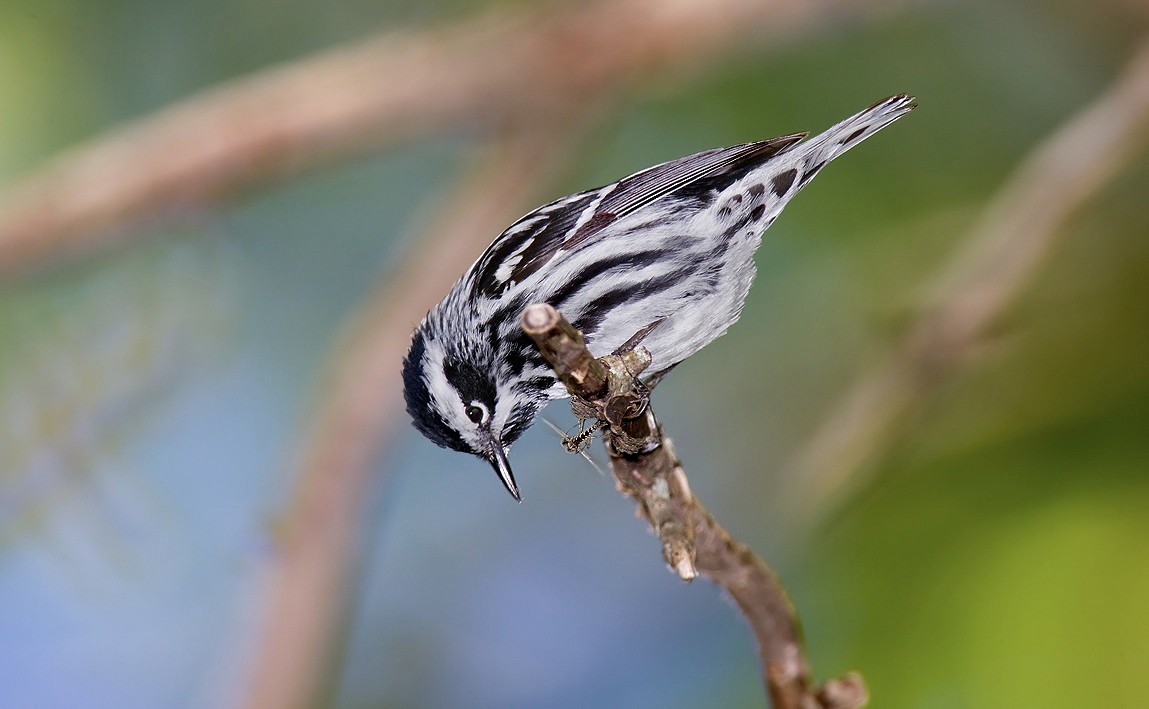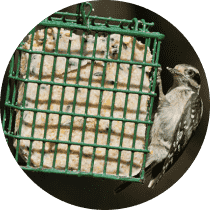Black-and-white Warbler
A species of Black-and-white Warblers Scientific name : Mniotilta varia Genus : Black-and-white Warblers
Black-and-white Warbler, A species of Black-and-white Warblers
Botanical name: Mniotilta varia
Genus: Black-and-white Warblers
Content
Description People often ask General Info
 Photo By William H. Majoros , used under CC-BY-SA-3.0 /Cropped and compressed from original
Photo By William H. Majoros , used under CC-BY-SA-3.0 /Cropped and compressed from original Description
The black-and-white warbler is 11 cm (4.3 in) to 13 cm (5.1 in) in length with a mass of 8 g (0.28 oz) to 15 g (0.53 oz) grams. Wingspan ranges from 7.1-8.7 in (18-22 cm). True to their name, black-and-white warblers are black and white in colour. Both sexes have black and white crowns with a white eyebrow, black streaking on a white belly, black wings with two white wing bars, a black tail, a black-and-white streaked back, streaky undertail coverts, and grey-black legs and feet. Breeding males have a black-and-white streaked throat and black cheek, while females have a grey cheek and a white-cream coloured throat and sides. First fall males are very similar to adult females in colour and patterning, while first fall females resemble to adult females but with less streaking and a more noticeable buffy wash. Juveniles are heavily spotted, and are similar to first fall individuals otherwise. This species is 12 cm (5 in) long and weighs 11 g (0.39 oz). The summer male black-and-white warbler is boldly streaked in black and white, and the bird has been described as a flying humbug. Each wing is black with two white wing bars. Female and juvenile plumages are similar, but duller and less streaky than males. This warbler can be confused with the blackpoll warbler (Setophaga striata). The blackpoll warbler is also black and white in its summer plumage, but has a solid black cap. The black-and-white warbler can also be confused behaviourally with the pine warbler (Setophaga pinus) and yellow-throated warbler (Setophaga dominica). 
Size
13 cm (5 in)
Colors
Black
Gray
White
Life Expectancy
11 years
Nest Placement
Ground
Clutch Size
4 - 6 eggs
Incubation Period
1 - 2 broods
Number of Broods
10 - 12 days
Nestling Period
8 - 12 days
Feeding Habits
Black-and-white Warbler's diet consists primarily of insects, notably moth and butterfly larvae, ants, flies, beetles, wood-borers, leafhoppers, and spiders. Uniquely, black-and-white Warbler forages like a nuthatch, moving along tree trunks and branches using its short legs and long hind toe for gleaning insects beneath bark surfaces. During migration, black-and-white Warbler may join mixed-species flocks.
Habitat
Black-and-white Warbler is commonly found in mature, deciduous, and mixed woodlands, showing a strong preference for vertical tree trunks and larger branches. They are adaptable to various altitudes and climates, thriving in both temperate and tropical zones. Commonly occurring in mature and successional growth forests, black-and-white Warbler may also inhabit swampy woods, riparian zones, and during migration, are drawn to woodlots. While wintering, the species' habitats extend to tropical mangroves, diverse forest types including cloud forests, and human-modified landscapes such as gardens and shade coffee plantations.
Nest Behavior
The female black-and-white Warbler builds the nest, lays the eggs, and with the male, cares for the young.
Nest Characteristics
Black-and-white Warbler typically selects a hidden nest site on the ground or occasionally up to six feet high. The open cup-shaped nest, over 5 inches wide and high, comprises leaves, bark, grass, pine needles, and is lined with moss and hair.
Dite type
Insectivorous
People often ask
General Info
Feeding Habits
Bird food type
Bird Feeder Type

Small Tube Feeder

Suet Cage
Sounds
Call
Recording location: United States
Song
Recording location: United States
Song
Recording location: United States
Behavior
Black-and-white Warbler exhibits a distinctive foraging style compared to other warblers, actively crawling along tree trunks and branches in multiple directions to meticulously search for insects hidden in bark crevices. They utilize dead wood and the tips of branches as part of their varied feeding grounds. During the breeding season, males arrive first, establishing and vigorously defending their territories with prolonged displays of aggression and song, outlasting similar behaviors in other species. Courtship involves the male engaging in close pursuit and wing-fluttering displays to woo his mate. The pair collaborates in nesting, with the female taking the lead in site selection and construction, often at ground level, expertly blending their nests with surrounding debris and vegetation.
Distribution Area
The black-and-white warbler is a migratory species, breeding in North America and wintering in North and South America. It is typically found in deciduous forest in its breeding range, but becomes more of a habitat generalist in the non-breeding season. 
Species Status
The IUCN classifies the black-and-white warbler as Least Concern due to its large range and population size. However, its population is decreasing. Habitat loss and degradation, especially forest fragmentation, are the main factors contributing to the species’ decline. If habitat loss continues, in either or both summer or wintering habitat, the species may continue to decline in the future. Pesticides such as fenitrothion and phosphamidon have contributed to the species’ decline in the 1970s, and others such as chlorinated hydrocarbons may continue to have an effect. 
Scientific Classification
Phylum
Chordates Class
Birds Order
Perching birds Family
New world warblers Genus
Black-and-white Warblers Species
Black-and-white Warbler